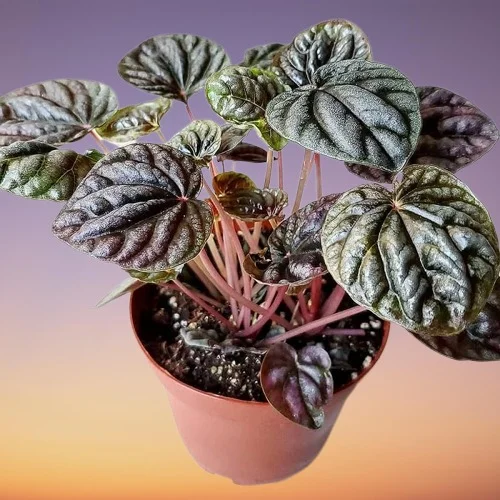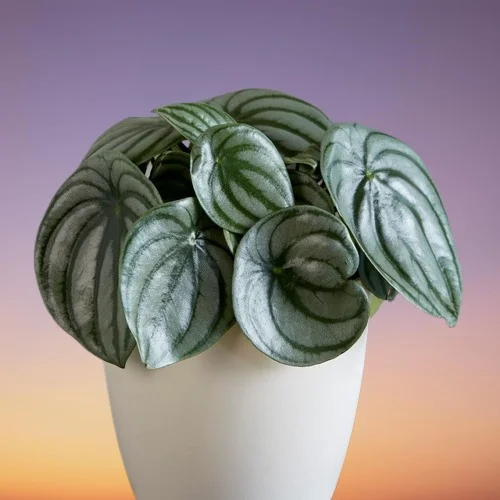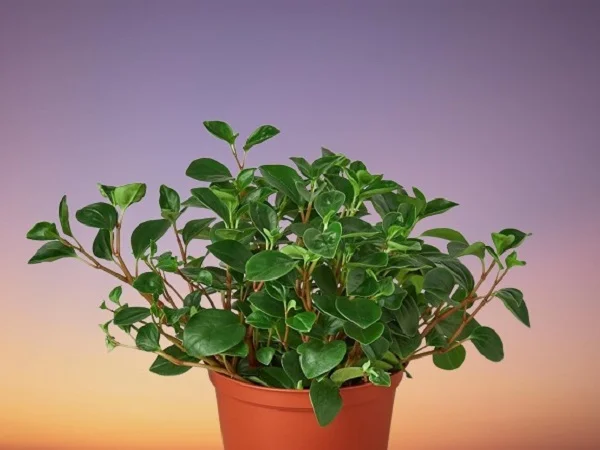15 Types of Peperomia Plants Varieties with Pictures and Care Guides
Some links in this post may be affiliate links
Most Peperomia Varieties are popular plants as they easily adapt to a wide range of growing conditions. The great variety of their beautiful foliage, texture and growth habits qualify them for any plant collection.
Peperomia are tropical plants which bear decorative foliage and typically prefer shadier conditions with more humidity. Some might even require a terrarium or a bottle garden to maintain high humidity.
The succulent Peperomia should be treated like cacti and other succulents, as they can tolerate more light and will survive a dry cold period, during which they are watered very rarely. Most Peperomia require loose, rich, well-drained soil and like to dry out to some extent or even completely between waterings.

One of the major reason you may lose your Peperomia is through root-rot due to over-watering or soggy soil. Therefore, take care not to overwater and ensure that the soil is well-drained and the pot has a drainage hole.
Peperomias are considered non-toxic and are ideal for households with children or animals. We have below outlined for you 15 popular Peperomia that you can grow successfully.
15 Popular Peperomia Varieties for Growing in the Home
Popular Peperomia varieties include Peperomia caperata, Peperomia argyreia, Peperomia obtusifolia, Peperomia prostrata, Peperomia scandens 'Variegata', Peperomia rotundifolia, Peperomia graveolens among others.
1. Emerald Ripple Peperomia (Peperomia caperata)

Emerald Ripple Peperomia is a popular, compact, perennial plant that is easy to grow in the home as it adapts well to various growing conditions.
A slow grower, Emerald Ripple Peperomia grows to a maximum height of 12 inches. The leaves are about 1 inch long, heart-shaped and deeply ridged and are usually green but may have a blush of red and dark-green veins. On account of its compact size, it is one of the best low-light plants for the limited spaces.
Peperomia caperata flourishes in average warmth of 15-260C, humidity of 60-70%, medium to bright indirect light and moderately moist, fertile, free-draining, all purpose potting soil coupled with regular feeding during the growing season.
Read more on how to grow and care for Emerald Ripple Peperomia (Peperomia caperata)
2. Watermelon Peperomia (Peperomia argyreia)

Watermelon Peperomia also called Watermelon Begonia is one of the popular, compact, upright, bushy, Peperomia plants which grows to a height of about 12 inches.
The slightly-fleshy, oval-shaped, green leaves are strikingly marked with curved silver stripes which causes them to resemble the skin of a watermelon making Watermelon Begonia among the best plants for the home.
Peperomia argyreia blossoms in bright light away from direct sunlight, average warmth of 18-250C, humidity of 50-60% and moderately moist, rich, well-drained, succulents potting mix coupled with monthly feeding in the growing period.
Learn more on how to grow and care for Watermelon Peperomia (Peperomia argyreia)
3. Pepper Face Plant (Peperomia obtusifolia)

Pepper Face Plant also called Baby Rubber Plant or American Rubber Plant is a compact, upright-growing Peperomia with cupped leathery leaves and resembles a miniature rubber plant and hence the common name, 'Baby Rubber Plant'.
Baby Rubber Plant is a popular, evergreen, perennial, native to the tropical rain forests and has numerous cultivars including variegated ones. It is one of the best tropical foliage plants for the home, office and other suitable places.
Peperomia obtusifolia grows best in bright light away from direct sunshine, moderate warmth of 18-250C, average humidity of 50-55% and moderately moist, rich, well-drained, all purpose potting soil coupled with monthly feeding during the growing season.
Read more on how to grow and care for Pepper Face Plant (Peperomia obtusifolia)
4. String of Turtles Plant (Peperomia prostrata)

String of Turtles Plant also called Magic Marmer is a popular, compact perennial plant that is easy to grow and adapts well to indoor growing conditions.
The veining on the leaves in String of Turtles Plant gives them the look of tiny turtles and hence the common name. It is one of the popular string of plants ideal for growing in the home or office.
Peperomia prostrata prospers in bright light with 4-6 hours of direct sunlight, average warmth of 18-250C, humidity of 50-55% and moderately moist, fertile, well-drained, succulents potting mix coupled with monthly feeding during the growing season.
Learn how to grow and care for String of Turtles Plant (Peperomia prostrata)
5. Variegated Cupid Peperomia (Peperomia scandens 'Variegata')

Variegated Cupid Peperomia Plant also called False Philodendron is a trailing Peperomia which bears fleshy, green, heart-shaped leaves with cream-colored, golden, yellow, or off-white markings.
The stems are pink colored and semi-succulent. The trailing stems can spread to a length of 5 feet and makes False Philodendron one of the best plants for a hanging basket.
Variegated Cupid Peperomia requires medium to bright indirect light (away from direct sunlight), average warmth of 15-260C, humidity of 55-65% and moderately moist, fertile, all purpose soil coupled with monthly feeding during the growing season.
Learn more on how to grow and care for Peperomia scandens 'Variegata'
6. Trailing Jade Plant (Peperomia rotundifolia)

Trailing Jade Plant also called Jade Necklace, Creeping Peperomia, Creeping Buttons and Round Leaf Peperomia, is one of the trailing, succulent Peperomia plants. It is one of the best succulent plants for hanging baskets.
Jade Necklace bears hanging shoots and very small, thick and fleshy, succulent, button-like leaves that may entwine and weave in and out of each other. It is easily propagated from leaf cuttings.
Peperomia rotundifolia prefers medium to bright indirect light (filtered light), average warmth of 15-260C, humidity of 55-65% and moderately moist, fertile, succulents potting mix coupled with monthly feeding during the growing season.
Read more on how to grow and care for Trailing Jade Plant (Peperomia rotundifolia)
7. Parallel Peperomia (Peperomia puteolata)

Parallel Peperomia is among the popular trailing Peperomia which produces cascading stems with attractive patterns similar to the stripes found on watermelon rinds.
The leaves are oval-shaped, patterned in dark green and white and grow in whorls around the plant stems. The stems are a deep maroon or reddish color These characteristics make Parallel Peperomia one of the best plants for an office space where they can be a great conversation starter.
Peperomia puteolata flourishes in medium to bright indirect light (filtered light), average warmth of 15-260C, humidity of 55-65% and moderately moist, rich, well-drained, all purpose potting soil coupled with monthly feeding during the growing season.
Learn more on how to grow and care for Parallel Peperomia (Peperomia puteolata)
8. Ruby Glow Peperomia (Peperomia graveolens)

Peperomia graveolens also called Ruby Peperomia is among the easy-care Peperomia plants which bears gleaming red stems in wine-red color and succulent leaves with a wine-red shade.
The upper part of the leaf has a transparent v-shaped ‘window’ which allows for photosynthesis to occur. The flowers are insignifant and have a faint unpleasant odor which gives this plant the species name, 'graveolens', which means 'bad smelling'.
On account of its spectacular foliage and ease of care, Ruby Peperomia is one of the best plants for the living room where it can create a great first impression.
Peperomia graveolens blossoms in medium to bright indirect light (away from direct sunlight), average warmth of 15-240C, humidity of 50-55% and moderately moist, rich, well-drained, succulents potting mix coupled with monthly feeding in the growing season.
Learn how to grow and care for Ruby Glow Peperomia (Peperomia graveolens)
9. Coin-leaf Peperomia (Peperomia polybotrya)

Coin-leaf Peperomia Plant also called Raindrop Peperomia or Coin Plant is a succulent, compact plant which bears glossy, dark-green, heart-shaped leaves with pale green undersides.
The stems are short and sturdy and it grows to a height of about 1 foot which makes it perfect for the limited spaces. The flowers are rat-tail like and they offer a pleasant smell.
Raindrop Peperomia is a succulent, compact plant which resembles Pilea peperomioides (Chinese Money Plant) though the plants are quite different in the shape of the leaves. Where the leaves in the former are more pointed and heart-shaped while in the latter they are rounded.
Coin-leaf Peperomia (Peperomia polybotrya) prospers in medium to bright indirect light, moderate warmth of 15-260C, average humidity of 50-55% and moderately moist, rich, well-drained, succulents potting soil coupled with monthly feeding during the growing season.
Read more on how to grow and care for Coin-leaf Peperomia Plant (Peperomia polybotrya)
10. Wax Privet Peperomia (Peperomia glabella)

Wax Privet Peperomia also called Cypress Peperomia is a popular Peperomia plant with beautiful oval leaves and red stems where the foliage is fleshy and often has variegation.
The leaves can be a darker or a lighter green, depending on the amount of light the plant receives. Likewise, the petioles and stems vary from pink to red depending on the amount of light. The flowers are small and insignificant.
Cypress Peperomia is a small, hardy, fast-growing, low-light plant whose stems will spread or trail with ease. It is one of the best fast-growing, low-light plants for the home.
Peperomia glabella flourishes in medium to bright indirect light (dappled light), average warmth of 15-260C, humidity of 60-70% and moderately moist, rich, well-drained, all purpose potting mix coupled with monthly feeding during the growing season.
Learn more on how to grow and care for Wax Privet Peperomia (Peperomia glabella)
11. Beetle Peperomia (Peperomia angulata)

Beetle Peperomia also called Beetle Raditor Plant is among the popular trailing Peperomia varieties and bears fragile reddish stems and has a trailing or a hanging habit.
The leaves are fleshy, oval-shaped, glossy, dark-green with light green lines and look like small Beetles, hence, the common name, 'Beetle Peperomia'.
Peperomia angulata thrives in medium to bright indirect light, average warmth of 15-260C, humidity of 60-70% and moderately moist, rich, well-drained, all purpose potting mix coupled with monthly feeding during the growing season.
Read more on how to grow and care for Beetle Peperomia (Peperomia angulata)
12. Red Log Plant (Peperomia verticillata)

Red Log Plant also called Whorled Peperomia or Belly Button is a compact, evergreen plant which bears fleshy, dark-green, cupped leaves with red wine-colored undersides.
Whorled Peperomia is succulent plant whose stems start upright but eventually spill over due to weight of the leaves and begin to trail or creep on the soil surface. It is one of the popular succulent plants for the home, office and other suitable places.Peperomia verticillata blossoms in bright indirect light (away from direct sunshine), average warmth of 15-260C, average humidity of 50-55% and moderately moist, rich, succulents potting soil coupled with monthly feeding in the growing season.
Learn how to grow and care for Red Log Plant (Peperomia verticillata)
13. Pearly Peperomia (Peperomia columella)

Pearly Peperomia also called Columnar Peperomia is a succulent plant which bears fleshy, upright stems from which arise tightly packed, alternately arranged succulent leaves.
Columnar Peperomia leaves are fleshy, bright green and bear the shape of a horseshoe. At the leaf apex is a transparent window through which light gets to the photosynthetic tissue. The transparent windows are water storage structures which come in handy in drought conditions and place this plant among the best drought-tolerant plants.
Pearly Peperomia (Peperomia columella) flourishes in bright indirect light (dappled light), average warmth of 15-260C, moderate humidity of 50-55% and moderately moist, fertile, well-drained, succulents potting mix coupled with monthly feeding during the growing season.
Read more on how to grow and care for Pearly Peperomia (Peperomia columella)
14. Peperomia Ginny (Peperomia clusiifolia)

Peperomia Ginny also called Peperomia Jelly, Peperomia Red-edge or Peperomia Tricolor is a herbaceous plant which bears fleshy oval-shaped leaves that are pointed at the tips.
The leaves are often light green with darker green coloring in the center and red or pink edges. They feel like jelly to the touch and hence the common name, 'Peperomia Jelly'.
Peperomia Jelly is ideal for a hanging basket, tabletop, desktop, pedestal or plant shelf where the trailing stems can cascade beautifully down the sides of the pot. It is one of the best low-light plants for any space in the home.
Peperomia clusiifolia thrives in medium to bright indirect light (filtered light), average warmth of 15-260C, humidity of 60-70% and moderately moist, rich, well-drained, all purpose potting soil coupled with monthly feeding during the growing season.
Learn more on how to grow and care for Peperomia Ginny (Peperomia clusiifolia)
15. Teardrop Peperomia (Peperomia orba)

Peperomia orba is a semi-succulent, slow growing, compact plant which grows to a height of about 6 inches and bears delicate, fleshy, oval-shaped, dark-green leaves and hence the name teardrops.
When the plant matures, a white line appears down the center of the waxy leaves. The stems are fleshy, red and grow by trailing stems which makes this plant perfect for a hanging basket. It is among the best plants for limited spaces in the home or office.
Peperomia orba performs best in medium to bright indirect light, average warmth of 15-260C, above average humidity of 60-75% and moderately moist, rich, well-drained, succulents potting soil coupled with monthly feeding during the growing season.
Learn how to grow and care for Teardrop Peperomia (Peperomia orba)

